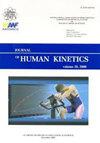Influence of Intensity on Post-Running Jump Potentiation in Recreational Runners vs. Physically Active Individuals
IF 1.9
3区 医学
Q2 SPORT SCIENCES
引用次数: 1
Abstract
The aim of this study was to verify post-activation performance enhancement (PAPE) in jumping and sprinting after two endurance volume-equated running protocols with different intensities, in runners vs. active individuals. Nine recreational runners (age: 34.5 ± 9.3 years, body mass: 73.1 ± 11.9 kg, body height: 1.76 ± 0.06 m, 17.4 ± 4.4 %body fat; maximum aerobic speed [MAS]: 16.4 ± 1.0 km·h−1), and 9 active individuals (age: 34.1 ± 9.4 years; body mass: 83.2 ± 7.7 kg; body height: 1.79 ± 0.06 m; 25.6 ± 5.4 %body fat; MAS: 13.3 ± 1.2 km·h−1) volunteered for participation. The evaluations were performed over three days as follows: 1) anthropometric measures, physical fitness tests, and the University of Montreal Track Test (UMTT) to determine MAS and the distance to be covered in the running protocols; 2 and 3) the countermovement jump (CMJ) and the flying 20-m sprint (SPRINT) were assessed pre- and post-running at 70% of MAS or a time trial race (TTR), equated by volume and completed in random order. A three-way ANOVA (time*group*running) was performed to analyze the PAPE effects. The results showed a time effect (F = 10 .716; p < 0.01) and a group*running interaction (F = 12.094; p < 0.01) for the CMJ, indicating that active individuals demonstrated PAPE after running at 70% of MAS, while for runners both running interventions (70% of MAS and TTR) induced PAPE in CMJ performances. For the SPRINT, a time*group interaction (F = 4.790; p = 0.044) and a group effect were observed, with runners showing greater SPRINT performances than active individuals. From the current results, it can be suggested that training background and intensity can modulate PAPE responses in jumping and sprinting after volume-equated running protocols at different intensities.强度对休闲跑步者与体力活动者跑后跳增强的影响
本研究的目的是验证两种耐力量相等的不同强度跑步方案后,跑步者与活跃个体在跳高和短跑中的激活后性能增强(PAPE)。9名休闲跑者(年龄:34.5±9.3岁,体重:73.1±11.9 kg,身高:1.76±0.06 m,体脂率17.4±4.4%;最大有氧运动速度[MAS]: 16.4±1.0 km·h−1),运动个体9例(年龄:34.1±9.4岁;体重:83.2±7.7 kg;体高:1.79±0.06 m;体脂25.6±5.4%;MAS: 13.3±1.2 km·h−1)自愿参加。评估在三天内进行如下:1)人体测量、体能测试和蒙特利尔大学跑道测试(UMTT),以确定MAS和跑步方案中要覆盖的距离;2、3)以70%的MAS或计时赛(TTR)进行跑前和跑后的反动作跳跃(CMJ)和飞行20米冲刺(sprint),按体积相等,按随机顺序完成。采用三向方差分析(时间*组*运行)分析PAPE效应。结果显示存在时间效应(F = 10.716;p & lt;0.01)和组*跑步交互作用(F = 12.094;p & lt;0.01),表明运动个体在以70%的MAS跑步后表现出PAPE,而跑步干预(70%的MAS和TTR)均诱导了CMJ表现的PAPE。对于SPRINT, a时间*组交互作用(F = 4.790;p = 0.044),并且观察到群体效应,跑步者比积极运动的人表现出更好的SPRINT表现。从目前的结果来看,训练背景和强度可以调节不同强度的等量跑步方案后跳跃和短跑中的PAPE反应。
本文章由计算机程序翻译,如有差异,请以英文原文为准。
求助全文
约1分钟内获得全文
求助全文
来源期刊

Journal of Human Kinetics
医学-运动科学
CiteScore
4.80
自引率
0.00%
发文量
83
审稿时长
3 months
期刊介绍:
The Journal of Human Kinetics is an open access interdisciplinary periodical offering the latest research in the science of human movement studies. This comprehensive professional journal features articles and research notes encompassing such topic areas as: Kinesiology, Exercise Physiology and Nutrition, Sports Training and Behavioural Sciences in Sport, but especially considering elite and competitive aspects of sport.
The journal publishes original papers, invited reviews, short communications and letters to the Editors. Manuscripts submitted to the journal must contain novel data on theoretical or experimental research or on practical applications in the field of sport sciences.
The Journal of Human Kinetics is published in March, June, September and December.
We encourage scientists from around the world to submit their papers to our periodical.
 求助内容:
求助内容: 应助结果提醒方式:
应助结果提醒方式:


